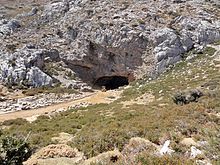Psychro Cave
| Psychro Cave | |
|---|---|
 Floodlit stalagmites and stalactites in the cave’s interior | |
| Location | Crete, Greece |
| Coordinates | 35°09′46″N 25°26′42″E / 35.1629°N 25.4451°E |
Psychro Cave (
Geography
The village of Psychro (35°09′54″N 25°27′04″E / 35.165°N 25.451°E) is 1,025 metres above sea level.[citation needed] The cave is located in the prefecture of Lasithi. In Minoan times, the town of Malia was the closest metropolitan center.
Myth
Dictaean Cave is famous in
Archaeology
The cave was first excavated in 1886 by Joseph Hatzidakis, President of the Syllogos at Candia, and F. Halbherr.[4] In 1896, Sir Arthur Evans investigated the site.[5]
In 1898 Pierre Demargne conducted brief investigations,
The undisturbed lowest strata of the upper cave represented the transition between Late Minoan Kamares ware to earliest Mycenaean levels; finds represented the Geometric Style of the ninth century BCE, but few later than that. More recent excavation has revealed the use of the cave reached back to Early Minoan times, and votive objects attest to the cave's being the most frequented shrine by Middle Minoan times (MM IIIA).[9]

The lower grotto falls steeply with traces of a rock-cut stair to a pool, out of which
In 1961, the art historian and archaeologist John Boardman published the finds uncovered by these and other excavations.[citation needed]
While clay human figurines are normally found in
Psychro yielded an uncommon number of semi-precious stones, including
.Psychro's artefacts are now on display at the Heraklion Museum, the Ashmolean Museum in Oxford, the Louvre and the British Museum.[10]
Idaean Cave

Idaean Cave (Greek: Ιδαίο άντρο) is a system of caves located on the slopes of Mount Ida on Crete (35°12′30″N 24°49′44″E / 35.2082°N 24.8290°E). The deep cave has a single entrance and features stalagmites and stalactites.
In
Excavations have revealed a large number of votive cult offerings on the site.
See also
Notes
- ^ MacGillivray, Alexander, and Hugh Sackett. “The Palaikastro Kouros: the Cretan God as a Young Man”, p. 167, British School at Athens Studies, vol. 6, 2000, pp. 165–169. JSTOR. Accessed 22 Feb. 2021
- ^ Bibliotheke, 1.1.6.
- ^ a b William Smith, ed. (c. 1873). A Dictionary of Greek and Roman biography and mythology. John Murray.
- ^ F. Halbherr and P. Orsi, "Scoperte nell' Antro di Psychro", Museo dell' Antichità Classico 2 1888 pp. 905-10.
- ^ Evans, "Further discoveries of Cretan and Aegean scripts," JHS 17 (1897), pp 305-57.
- ^ P. Demargne, "Antiquités de Praesos et de l'Antre Dictéen" Bulletin de Correspondence Héllenique 26 (1902), pp. 571-583.
- ^ D. G. Hogarth, "The Cave of Psychro in Crete" The Journal of the Anthropological Institute of Great Britain and Ireland 30 (1900), pp. 90-91; D. G. Hogarth, "The Dictaean cave" The Annual of the British School at Athens 6 (1899/1900), pp. 94-116.
- ^ W. Boyd-Dawkins, "Remains of Animals Found in the Dictaean Cave in 1901," Man 32 (1902) Royal Anthropological Institute of Great Britain and Ireland, pp. 162-65.
- ^ L. Vance Watrous and H. Blitzer, "Lasithi: A History of Settlement on a Highland Plain in Crete" Hesperia Supplements 18 (1982), pp. i-xiv,1-122.
- ^ British Museum Collection
References
- Jones, Donald W. (1999). Peak Sanctuaries and Sacred Caves in Minoan Crete ISBN 91-7081-153-9
- Rutkowski, B., and Krzysztof Nowicki (1996). The Psychro Cave and Other Sacred Grottoes in Crete (Warsaw: Polish Academy of Science)
- Watrous, L. Vance (1996). The Cave Sanctuary of Zeus at Psychro: A Study of Extra-Urban Sanctuaries in Minoan and Early Iron Age Crete (Liège/Austin: Université de Liège / University of Texas at Austin)

